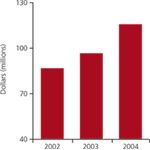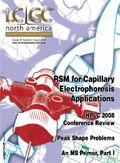India
Although the Indian economy has garnered world attention with its importance in the IT and service sectors, the country recently has become far more prominent in industries that are strong sources of demand for analytical instrumentation. Foremost among these is the pharmaceutical industry, as India is now the fourth largest country in terms of production volume.
Although the Indian economy has garnered world attention with its importance in the IT and service sectors, the country recently has become far more prominent in industries that are strong sources of demand for analytical instrumentation. Foremost among these is the pharmaceutical industry, as India is now the fourth largest country in terms of production volume. Furthermore, it's no longer valid to consider India as only a source of generic drugs. Multinational drug companies have opened R&D facilities in India, and the domestic pharmaceutical companies are close to bringing the first-ever Indian drug to market. Biotechnology also is being supported by foreign investment and government spending.

Market demand in India by separation technique.
Life science research may be the biggest story, but it is not the only story. In an economy that has been growing 8–9% over the last few years, many Indian industries are thriving: metals and mining, cement, semiconductors, chemicals, and petrochemicals. After years of relatively modest spending, government investment in science has also accelerated. In fact, the 2008–2009 budget calls for a 20% increase in the Ministry of Science and Technology, a prime source of research spending.
India has a small, but growing, domestic industry in the production of analytical instruments and equipment. In 2004, separations technologies (HPLC, GC, IC, LPLC, CE, and others) formed the largest technology segment within the Indian analytical instrument market. While the global market is composed of many different individual techniques, the market in India almost is restricted entirely to HPLC and GC. Other separation technologies are important, but currently account for only a minor portion of the overall Indian demand.
The foregoing data was extracted and adapted from SDi's Market Analysis and Perspectives (MAP) report, "Indian Instrument Demand and Production: Tyger, Tyger, Burning Bright." For more information, contact Glenn Cudiamat, VP of Research Services, Strategic Directions International, Inc., 6242 Westchester Parkway, Suite 100, Los Angeles, CA 90045, (310) 641-4982, fax: (310) 641-8851, e-mail: cudiamat@strategic-directions.com

Regulatory Deadlines and Supply Chain Challenges Take Center Stage in Nitrosamine Discussion
April 10th 2025During an LCGC International peer exchange, Aloka Srinivasan, Mayank Bhanti, and Amber Burch discussed the regulatory deadlines and supply chain challenges that come with nitrosamine analysis.
Top Execs from Agilent, Waters, and Bruker Take the Stage at J.P. Morgan Healthcare Conference
January 16th 2025The 43rd Annual Healthcare J.P. Morgan Healthcare Conference kicked off in San Francisco earlier this week. Here’s what top executives from Agilent, Bruker, and Waters, discussed during the event.

.png&w=3840&q=75)

.png&w=3840&q=75)



.png&w=3840&q=75)



.png&w=3840&q=75)





